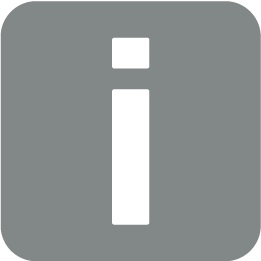EEBus
You can activate the EEBus protocol on the inverter using this menu item.
EEBus is a data communication standard for devices in the Smart Home. The EEBus standard is openly accessible to all device manufacturers.
|
Parameter |
Explanation |
|---|---|
Activate EEBus | The EEBus protocol is activated on the inverter. To allow external EEBus devices to communicate with the inverter, you must trust the external EEBus devices. |
Deactivate EEBus | The EEBus protocol is deactivated on the inverter. EEBus devices connected externally to the inverter can no longer exchange data. |
This device
Overview of the EEBus device information.
|
Parameter |
Explanation |
|---|---|
SKI | Subject Key Identifier (device code/key) of the inverter. This is required for the connection to other EEBus devices. The QR code pictured includes the SKI. |
Model | Model name |
Name | Name of the EEBus device. The inverter name can be changed by going to Settings > Basic settings. |
QR code | The QR code contains all key information about the device for connecting it with other EEBus-compatible devices. |
Applications
Here, the applications available to the inverter are displayed. These can be used to read out or control the inverter.
|
Parameter |
Explanation |
|---|---|
Monitoring of Inverter (MOI) | The inverter provides inverter values. Connected devices can read out this value. |
Monitoring of Battery (MOB) | The inverter provides battery values. Connected devices can read out this value. |
Limitation of Power Production (LPP) | Limitation of power generation This application allows the inverter feed-in to be controlled by external sources. |
Limitation of Power Consumption (LPC) | Limitation of power drawn from the grid Using this application, the amount of power drawn from the grid by the inverter (e.g. to charge a connected battery from the grid) can be controlled by external parties. |
Monitoring of Power Consumption (MPC) | Monitoring of power consumption The inverter provides consumption values. Connected devices can read out this value. |
Paired devices
Displays the devices that are connected via EEBus.
Click on the device to see further information about the device or EEBus connection.
|
Parameter |
Explanation |
|---|---|
Model | Model name |
Make | Manufacturer |
Type | Information about the device type, e.g. energy manager. |
Status | Reports on the status of the connection. Available: A connection with the device can be requested. Hourglass - connection pending: The other party still needs to confirm the connection. Communication disrupted: The connection is currently disrupted. If this persists, check the connection to the external EEBus device. Tick - Paired: The connection is active. Revoke trust: If you click on an EEBus device, another window opens in which you can disconnect the connection by clicking on Decouple (revoke trust). |
Decoupling EEBus device
The Decouple action (revoke trust) is used to disconnect a connected and coupled EEBus device.
Clicking on the EEBus device symbol opens a dialogue window with further details.
- Click on Decouple (revoke trust) and close the window.
- The status has changed. The EEBus device is now again listed under Available devices. On the other hand, the connection should still be checked and decoupled.
- Device decoupled.
Available devices
Displays the available devices that have been found in the local network and that can be connected via EEBus.
If you click on an EEBus device on the list, more information about the device is displayed.
INFO

Only devices, which can communicate with the inverter for the purposes of power regulation (LPCC/LPP) or data retrieval (MOI/MOB/MGCP) should be coupled.
Other EEBus-capable devices may be coupled, but are not controlled by the inverter. This can lead to error messages or malfunctions for the coupled devices.
The following EEBus-capable devices are supported:
- control boxes at grid connection point (e.g. Smart Meter Gateway or control box from grid operator)
- energy management systems (device for managing the energy consumption / power generation of connected devices in the house)
- electric mobility devices (e.g. wallboxes)
- heating, ventilation and air conditioning devices/systems (e.g. heat pump)
- other inverters (PV/battery/hybrid inverter)
- domestic appliances, which support EEBus (e.g. washing machine, dryer, fridge etc.)
Click on the device you want to connect to and pair it. The devices then appear on the Paired devices list. The other party now needs to confirm the request for the connection to be fully set up.
|
Parameter |
Explanation |
|---|---|
Model | Model name |
Make | Manufacturer |
Type | Information about the device type, e.g. energy manager. |
Decoupling EEBus device
Clicking on the EEBus device symbol opens a dialogue window with further details. To connect EEBus devices to each other, both devices must be coupled.
- To do this, click on Couple (pair) and close the window.
- The status has changed to Connection pending (hourglass).
- The counterparties now need to confirm the connection again. Once this has been done, the status changes to Coupled (paired, green tick).
Current limitation
If a limitation has been activated, you will see the current power limitation here.
You will see the fallback values in case of connection loss for LPC and LPP under the Info symbol.
Received limitations
History of received limitations.
|
Parameter |
Explanation |
|---|---|
Type | Shows the use case for which the limitation applies. |
Limit | Received value of limitation. |
Valid from | The limitation is valid from date/time. |
Valid until | The limitation is valid until date/time. |